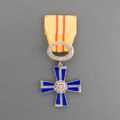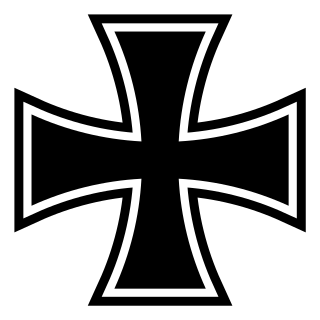
The Iron Cross was a military decoration in the Kingdom of Prussia, and later in the German Empire (1871–1918) and Nazi Germany (1933–1945). The design, a black cross pattée with a white or silver outline, was derived from the insignia of the medieval Teutonic Order and borne by its knights from the 13th century. As well as being a military medal, it has also been used as an emblem by the Prussian Army, the Imperial German Army, and the Reichswehr of the Weimar Republic, while the Balkenkreuz variant was used by the Wehrmacht. The Iron Cross is now the emblem of the Bundeswehr, the modern German armed forces.
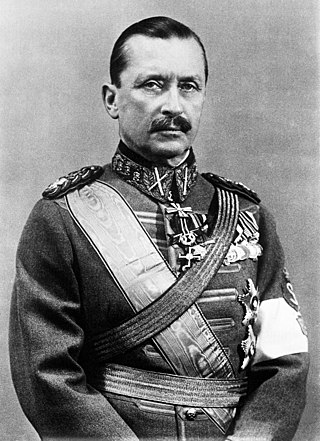
Baron Carl Gustaf Emil Mannerheim was a Finnish military leader and statesman. He served as the military leader of the Whites in the Finnish Civil War (1918), as Regent of Finland (1918–1919), as commander-in-chief of the Finnish Defence Forces during the period of World War II (1939–1945), and as the sixth president of Finland (1944–1946). He became Finland's only field marshal in 1933 and was appointed honorary Marshal of Finland in 1942.
The Mannerheim Cross, officially Mannerheim Cross of the Cross of Liberty is the most distinguished Finnish military honour. A total of 191 people received the cross between 22 July 1941 and 7 May 1945, with six of the recipients receiving a cross twice. Available in two classes, the 1st class medal has only been awarded twice, with both recipients also having received the medal in the 2nd class. Although still active de jure, no crosses have been awarded since 1945. Tuomas Gerdt, the last living Knight of the Mannerheim Cross, died on 1 November 2020.
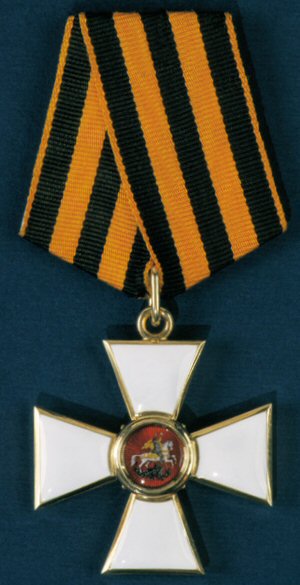
The Order of Saint George is the highest military decoration of the Russian Federation. It was originally established on 26 November 1769 Julian as the highest military decoration of the Russian Empire for commissioned officers and generals by Empress Catherine the Great. After the October Revolution in 1917, it was awarded by the White movement under Alexander Kolchak until their collapse in 1921. The order was revived in the Russian Federation on 20 March 1992 by Decree №1463 of the President of Russia. The current award criteria were amended on 7 September 2010 by Presidential Decree 1099.
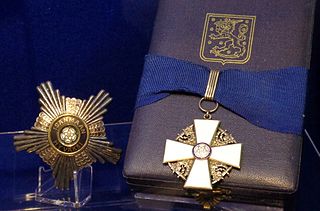
The Order of the White Rose of Finland is one of three official orders in Finland, along with the Order of the Cross of Liberty, and the Order of the Lion of Finland. The President of Finland is the Grand Master of all three orders. The orders are administered by boards consisting of a chancellor, a vice-chancellor and at least four members. The orders of the White Rose of Finland and the Lion of Finland have a joint board.

The Order of the Lion of Finland is one of three official orders in Finland, along with the Order of the Cross of Liberty and the Order of the White Rose of Finland. The President of Finland is the Grand Master of all three orders. The orders are administered by boards consisting of a chancellor, a vice-chancellor and at least four members. The orders of the White Rose of Finland and the Lion of Finland have a joint board. The President of Finland wears the Star of the Order of the Lion of Finland.

The War Merit Cross was a state decoration of Nazi Germany during World War II. By the end of the conflict it was issued in four degrees and had an equivalent civil award. A "de-Nazified" version of the War Merit Cross was reissued in 1957 by the Bundeswehr for its veterans.
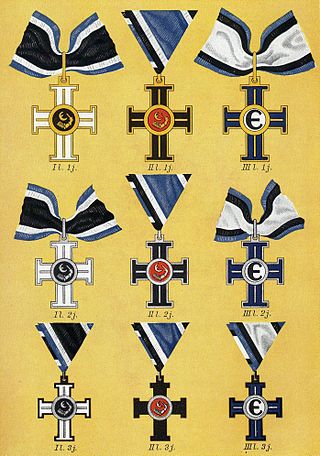
The Estonian Cross of Liberty is a military decoration established by the Prime Minister of Estonia, Konstantin Päts, on 24 February 1919 to honor the people for their services during the Estonian War of Independence. The Estonian Cross of Liberty has three divisions, each in three classes. Division I was granted for military leadership, division II for personal courage and division III for civilian services. The division and class of the Estonian Cross of Liberty is usually added to the name of the recipient in the form of post-nominal letters. The 1st class of the II division of the Estonian Cross of Liberty was never granted. Although still mentioned in the list of Estonian state decorations by the president of the republic, the bestowal of the Estonian Cross of Liberty was terminated on 19 June 1925.
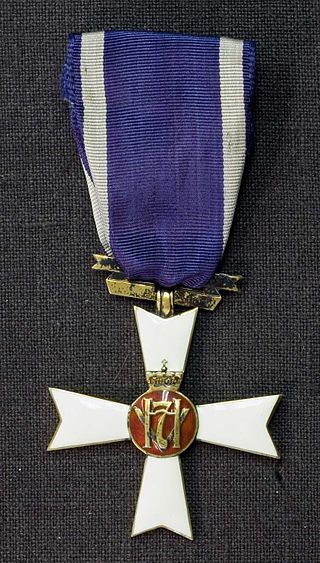
King Haakon VII's Freedom Cross was established in Norway on 18 May 1945. The medal is awarded to Norwegian or foreign military or civilian personnel for outstanding achievement in wartime. It is ranked fifth in the order of precedence in the Norwegian honours system.

The Order of Merit of the German Eagle was an award of the German Nazi regime, predominantly to foreign diplomats. The Order was instituted on 1 May 1937 by Adolf Hitler. It ceased to be awarded following the collapse of Nazi Germany at the end of World War II in Europe. The wearing of the Order of Merit of the German Eagle is prohibited in the Federal Republic of Germany.
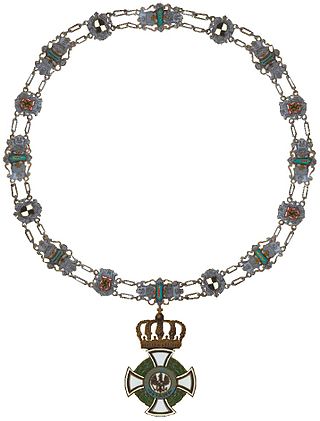
The House Order of Hohenzollern was a dynastic order of knighthood of the House of Hohenzollern awarded to military commissioned officers and civilians of comparable status. Associated with the various versions of the order were crosses and medals which could be awarded to lower-ranking soldiers and civilians.

The Imperial Austrian Order of Franz Joseph was founded by Emperor Franz Joseph I of Austria on 2 December 1849, on the first anniversary of his accession to the imperial throne.

The Military Order of Max Joseph was the highest military order of the Kingdom of Bavaria. It was founded on 1 January 1806 by Maximilian I Joseph of Bavaria, the first king of Bavaria. The order came in three classes:

The orders, decorations and medals of Finland form a system through which the Finnish government shows its respect to persons who have distinguished themselves on some walk of life. The legal basis of the system is the Act on the displays of public recognition (1215/1999) which grants the president the authority to issue decrees on orders, medals and titles.
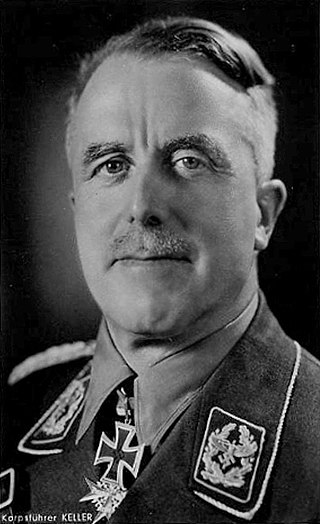
Alfred Keller was a general in the Luftwaffe of Nazi Germany during the Second World War who commanded the Luftflotte 1. His career in the Imperial German Armed Forces began in 1897; he served as a bomber pilot in World War I.

The Friedrich Order was an order of merit of the German Kingdom of Württemberg. It was instituted on 1 January 1830 by the second king of Württemberg, Wilhelm I in remembrance of his father, King Friedrich I. In 1918, the end of the monarchy meant the abolition of the order.

The Albert Order was created on 31 December 1850 by King Frederick Augustus II of Saxony to commemorate Albert III, Duke of Saxony. It was to be awarded to anyone who had served the state well, for civil virtue, science and art.
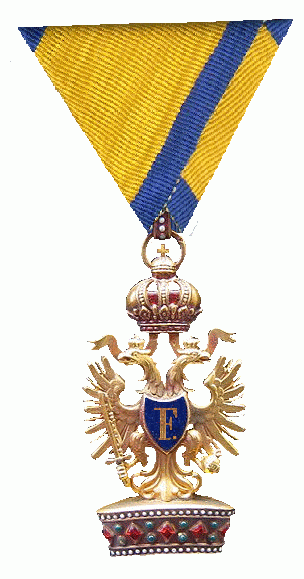
The Imperial Order of the Iron Crown was one of the highest orders of merit in the Austrian Empire and Austria-Hungary until 1918. It was founded in 1815 by Emperor Franz I of Austria as a re-establishment of the original Order of the Iron Crown, which previously had been an order of the Napoleonic Kingdom of Italy.

Hans Feige was a German General of the Infantry in the Wehrmacht during World War II.

The Order of the Holy Lamb is a semi-official ecclesiastical order of Finland awarded by the Orthodox Church of Finland. Under the patronage of the Finnish state, its Grand Master is the Archbishop of the Orthodox Church of Finland. The order can be awarded to anyone regardless of religion or nationality who have made services to the Church.





